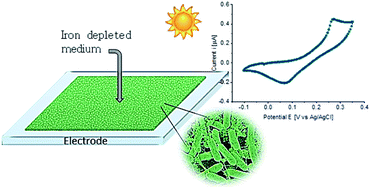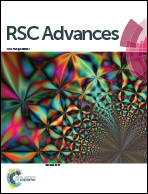Tapping into cyanobacteria electron transfer for higher exoelectrogenic activity by imposing iron limited growth†
Abstract
The exoelectrogenic capacity of the cyanobacterium Synechococcus elongatus PCC7942 was studied in iron limited growth in order to establish conditions favouring extracellular electron transfer in cyanobacteria for photo-bioelectricity generation. Investigation into extracellular reduction of ferricyanide by Synechococcus elongatus PCC7942 demonstrated enhanced capability for the iron limited conditions in comparison to the iron sufficient conditions. Furtheremore, the significance of pH showed that higher rates of ferricyanide reduction occurred at pH 7, with a 2.7-fold increase with respect to pH 9.5 for iron sufficient cultures and 24-fold increase for iron limited cultures. The strategy presented induced exoelectrogenesis driven mainly by photosynthesis and an estimated redirection of the 28% of electrons from photosynthetic activity was achieved by the iron limited conditions. In addition, ferricyanide reduction in the dark by iron limited cultures also presented a significant improvement, with a 6-fold increase in comparison to iron sufficient cultures. Synechococcus elongatus PCC7942 ferricyanide reduction rates are unprecedented for cyanobacteria and they are comparable to those of microalgae. The redox activity of biofilms directly on ITO-coated glass, in the absence of any artificial mediator, was also enhanced under the iron limited conditions, implying that iron limitation increased exoelectrogenesis at the outer membrane level. Cyclic voltammetry of Synechococcus elongatus PCC7942 biofilms on ITO-coated glass showed a midpoint potential around 0.22 V vs. Ag/AgCl and iron limited biofilms had the capability to sustain currents in a saturated-like fashion. The present work proposes an iron related exoelectrogenic capacity of Synechococcus elongatus PCC7942 and sets a starting point for the study of this strain in order to improve photo-bioelectricity and dark-bioelectricity generation by cyanobacteria, including more sustainable mediatorless systems.



 Please wait while we load your content...
Please wait while we load your content...